1932 Ford Cabriolet, a timeless masterpiece of automotive design, embodies the spirit of an era defined by innovation and elegance. The car’s sleek lines and powerful engine captured the imagination of a nation, becoming a symbol of American ingenuity and prosperity.
Born amidst the Great Depression, the 1932 Ford Cabriolet represented a beacon of hope and optimism. Its affordable price point and stylish design made it accessible to a wider audience, contributing to its immense popularity. The Cabriolet’s influence on automotive design is undeniable, shaping the aesthetics of American cars for decades to come.
Historical Context
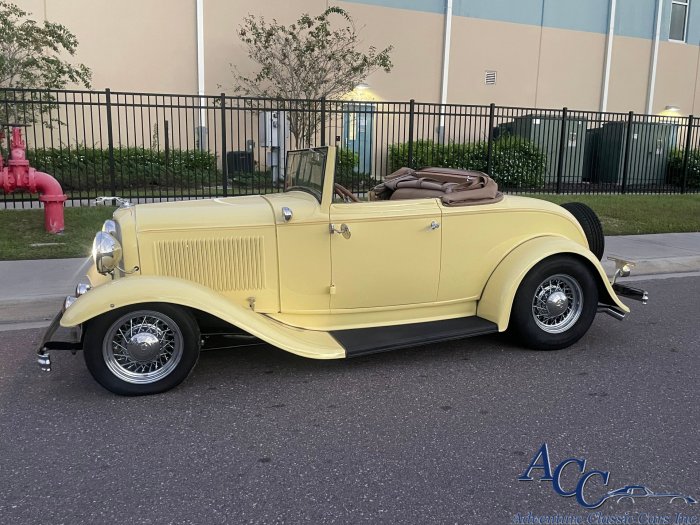
The 1932 Ford, particularly the Cabriolet model, holds a significant place in automotive history, marking a turning point in design and manufacturing practices. This era witnessed the emergence of a new automotive landscape, shaped by economic and social factors that influenced the car’s design, production, and subsequent impact on American society.
The 1932 Ford’s Significance in the Automotive Landscape
The 1932 Ford was a revolutionary model that ushered in a new era of automotive design and engineering. It marked a departure from the Model T, which had dominated the market for nearly two decades. The Model A, introduced in 1927, had already signaled a shift towards more modern styling, but the 1932 Ford went further, offering a sleeker, more aerodynamic design with a lower center of gravity.
The introduction of a V8 engine, previously unheard of in a mass-produced car, further solidified its place as a technological marvel.The 1932 Ford was also significant for its mass production capabilities. Ford’s assembly line system, pioneered with the Model T, was further refined and optimized, enabling the company to produce cars at an unprecedented rate.
This made the 1932 Ford affordable for a wider segment of the population, further solidifying its role as a symbol of American progress and innovation.
The Economic and Social Conditions that Shaped the 1932 Ford
The 1932 Ford Cabriolet’s design and production were heavily influenced by the economic and social conditions of the time. The Great Depression had gripped the nation, leading to widespread unemployment and a decline in consumer spending. This economic hardship led to a demand for affordable, reliable vehicles that could help people get around and find work.
In response to these conditions, Ford focused on creating a car that was both affordable and durable. The 1932 Ford’s design emphasized simplicity and practicality, while its V8 engine provided the power and efficiency needed to navigate the challenging economic landscape.
The 1932 Ford Cabriolet, a classic example of American automotive design, embodies the spirit of a bygone era. While its sleek lines and open-top design evoke a sense of freedom and luxury, it’s a stark contrast to the imposing presence of the 2000 Ford Excursion , a behemoth of an SUV designed for practicality and off-road capability.
Both vehicles, though separated by decades and purpose, represent Ford’s enduring legacy in the automotive world, showcasing its ability to adapt and innovate across diverse eras.
The Cultural Impact of the 1932 Ford Cabriolet
The 1932 Ford Cabriolet had a profound impact on American culture. Its sleek design and affordability made it a symbol of status and mobility, particularly for young people. The Cabriolet, with its open-top design, became associated with freedom and adventure, further contributing to its popularity.The 1932 Ford also played a role in shaping the American road trip.
Its durability and reliability made it an ideal vehicle for long-distance travel, contributing to the rise of the American road trip as a popular leisure activity. The car’s cultural influence can still be seen today, with its design elements and legacy continuing to inspire modern car enthusiasts.
Design and Features
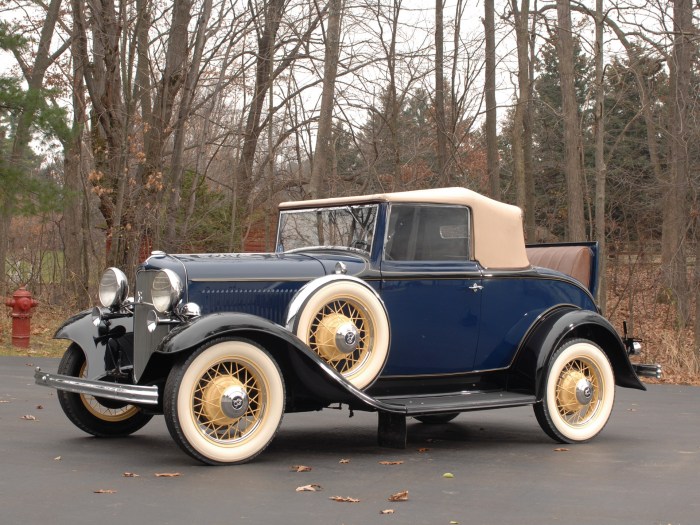
The 1932 Ford Cabriolet was a revolutionary vehicle that marked a significant shift in automotive design and technology. Its sleek, modern lines and innovative features made it a standout among its contemporaries.The Cabriolet’s design was a departure from the boxy, utilitarian vehicles of the past.
It featured a lower, more aerodynamic body with rounded fenders and a sloping hood. The distinctive grille, with its horizontal bars and Ford emblem, was a key design element.
Distinctive Design Elements
The 1932 Ford Cabriolet boasted several distinctive design elements that set it apart from other vehicles of its era.
- Sleek, Modern Lines:The Cabriolet’s streamlined body, with its rounded fenders and sloping hood, was a departure from the boxy designs of previous Fords. This aerodynamic design was not only stylish but also improved the vehicle’s performance.
- Distinctive Grille:The horizontal bars and Ford emblem on the grille were instantly recognizable and added a touch of elegance to the Cabriolet’s front end.
- Folding Soft Top:The Cabriolet’s most defining feature was its folding soft top, which allowed passengers to enjoy the open air while driving. This feature was a luxury for the time and contributed to the car’s sporty image.
Comparison with Other Ford Models
The 1932 Ford Cabriolet was a luxury model compared to other Ford vehicles of the era.
- Ford Model A:The Model A was a more affordable and utilitarian vehicle, with a simpler design and fewer features. The Cabriolet, on the other hand, was a luxury car aimed at a more affluent clientele.
- Ford Model B:The Model B was a more powerful and sophisticated vehicle than the Model A, but it lacked the Cabriolet’s stylish design and luxurious features.
Technical Innovations
The 1932 Ford Cabriolet incorporated several technical innovations that improved its performance and driving experience.
- V8 Engine:The Cabriolet was the first Ford model to feature a V8 engine, which provided more power and torque than previous Ford engines. This engine was a significant technological advancement and helped to establish the Ford V8 as a benchmark in the automotive industry.
- Independent Front Suspension:The Cabriolet’s independent front suspension provided a smoother and more comfortable ride than previous Ford models, which used a rigid front axle. This innovation was a major step forward in automotive technology and helped to improve the overall handling and stability of the vehicle.
- Hydraulic Brakes:The Cabriolet featured hydraulic brakes, which provided more responsive and consistent braking than the mechanical brakes used in previous Ford models. This innovation was a significant safety improvement and helped to enhance the driving experience.
Production and Sales

The 1932 Ford Cabriolet, a symbol of elegance and style, was a product of the Ford Motor Company’s meticulous manufacturing process. Its production and sales were significantly impacted by the Great Depression, highlighting the challenges faced by the automotive industry during that period.
Manufacturing Process, 1932 Ford Cabriolet
The 1932 Ford Cabriolet was assembled using a highly efficient and standardized process. The chassis was built on a dedicated assembly line, with each worker specializing in a specific task. The body was manufactured separately and then attached to the chassis.
The car’s engine, a powerful 85-horsepower V8, was produced at Ford’s Rouge Plant in Dearborn, Michigan. The final assembly process involved the installation of the interior, exterior trim, and other components.
Sales Figures and Market Reception
Despite the economic hardships of the Great Depression, the 1932 Ford Cabriolet found a niche market among those who could afford its luxury. The car’s stylish design and powerful engine made it a desirable option for the affluent. However, the high price tag and limited demand resulted in relatively low sales figures.
Impact of the Great Depression
The Great Depression significantly impacted the production and sales of the 1932 Ford Cabriolet. The economic downturn led to a sharp decline in consumer spending, and the demand for luxury automobiles like the Cabriolet plummeted. To mitigate the impact, Ford introduced cost-cutting measures, including reducing production runs and streamlining the manufacturing process.
The company also offered financing options to make the car more accessible to a wider audience.
Legacy and Impact: 1932 Ford Cabriolet
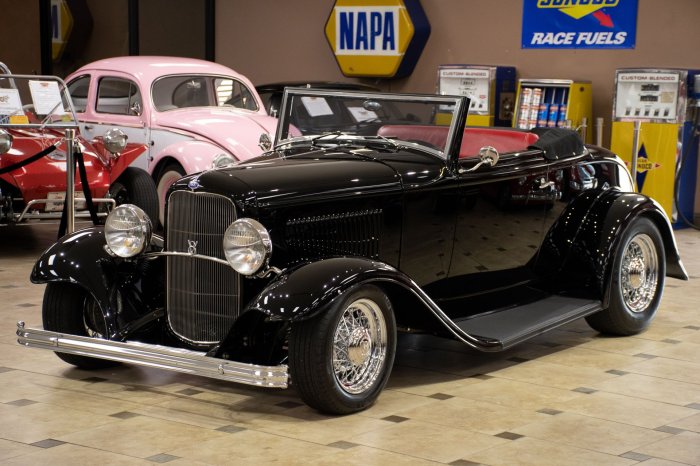
The 1932 Ford Cabriolet, a symbol of the roaring twenties and the dawn of the modern automotive era, continues to exert a significant influence on car design and culture. Its sleek lines, innovative features, and affordability revolutionized the automotive landscape, leaving an enduring legacy that continues to inspire designers and enthusiasts alike.
Impact on Subsequent Car Designs
The 1932 Ford Cabriolet’s influence on subsequent car designs is undeniable. Its streamlined body, characterized by its rounded fenders, sloping hood, and integrated headlights, set a new standard for automotive aesthetics. This design philosophy, known as “Art Deco,” emphasized elegance and functionality, inspiring carmakers for decades to come.
- Aerodynamics:The 1932 Ford Cabriolet’s aerodynamic design, with its rounded contours and integrated headlights, influenced the development of streamlined cars in the following decades. The emphasis on reducing wind resistance paved the way for more fuel-efficient and high-performance vehicles.
- Styling:The 1932 Ford Cabriolet’s sleek lines and integrated features, such as the concealed headlights, influenced the styling of cars for many years. The “Art Deco” aesthetic, characterized by geometric shapes and flowing curves, became a dominant trend in automotive design, shaping the look of cars from the 1930s to the 1950s.
- Mass Production:The 1932 Ford Cabriolet’s production process, which employed advanced assembly line techniques, helped to make cars more affordable and accessible to a wider audience. This paved the way for the mass production of automobiles, revolutionizing the automotive industry and driving economic growth.
Celebration and Preservation
The 1932 Ford Cabriolet’s enduring legacy is celebrated and preserved through various means:
- Classic Car Shows:The 1932 Ford Cabriolet is a popular fixture at classic car shows worldwide, where enthusiasts gather to admire and showcase these iconic vehicles. These events provide an opportunity for owners to share their passion for automotive history and to connect with other collectors.
- Museums:Several automotive museums around the world feature 1932 Ford Cabriolets in their collections, highlighting the car’s significance in automotive history. These museums provide a platform for visitors to learn about the car’s design, engineering, and cultural impact.
- Restoration and Preservation:Dedicated enthusiasts and restoration shops continue to preserve and restore 1932 Ford Cabriolets, ensuring that these iconic vehicles remain in good condition for future generations to enjoy. The restoration process involves meticulous attention to detail, using original parts or high-quality reproductions to maintain the car’s authenticity.
The 1932 Ford Cabriolet, with its sleek lines and iconic grille, represents a pivotal moment in automotive history. While it embodied the spirit of the roaring twenties, the 1930s saw a shift towards more streamlined designs, a trend that would later influence the iconic 1960 Ford Thunderbird.
The Thunderbird, with its powerful V8 engine and sporty convertible design, harked back to the elegance of the 1932 Ford Cabriolet, showcasing how automotive design can draw inspiration from the past while forging a path forward.
Notable Examples and Owners
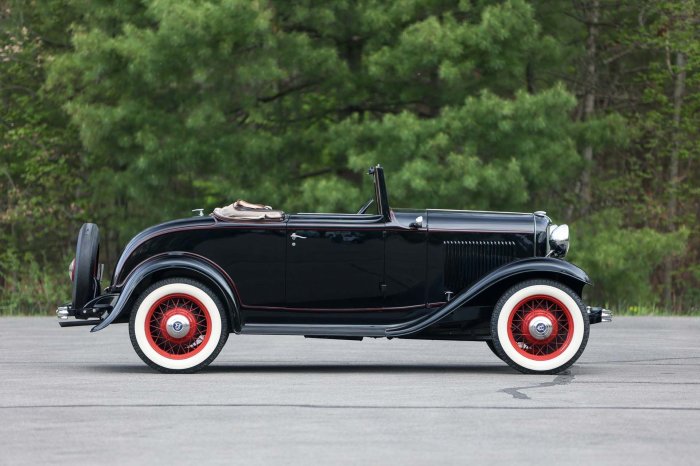
The 1932 Ford Cabriolet, with its elegant design and powerful engine, captured the hearts of many, attracting a diverse range of owners, from Hollywood stars to everyday individuals. These individuals, through their ownership, helped shape the legacy of the 1932 Ford Cabriolet, solidifying its place in automotive history.
Notable Examples of Restored or Preserved 1932 Ford Cabriolets
Several 1932 Ford Cabriolets have been meticulously restored or preserved, showcasing the enduring appeal and craftsmanship of this classic vehicle.
The 1932 Ford Cabriolet, a classic of the Art Deco era, embodies a timeless elegance. While its design predates the iconic 1967 Ford Mustang by decades, both vehicles share a common thread: they represent the American dream of freedom and mobility.
The 1932 Ford Cabriolet, with its open-top design and powerful engine, offered a taste of luxury and adventure, much like the Mustang would do later on.
- The 1932 Ford Cabriolet owned by Henry Ford himselfis a prime example of a preserved classic. This car, originally finished in black, is a testament to Ford’s vision and the enduring legacy of his company.
- Another notable example is the 1932 Ford Cabriolet that won the prestigious Pebble Beach Concours d’Elegance in 2012. This car, restored to its original glory, exemplifies the meticulous craftsmanship and dedication of restoration experts.
- The 1932 Ford Cabriolet owned by the renowned car collector, Jay Leno, is another testament to the enduring appeal of this classic. Leno, known for his extensive collection of vintage cars, has meticulously preserved this Cabriolet, ensuring its legacy for future generations.
Notable Owners of 1932 Ford Cabriolets
The 1932 Ford Cabriolet was owned by a diverse group of individuals, each contributing to the car’s enduring appeal and historical significance.
| Owner | Profession | Significance of Ownership |
|---|---|---|
| Henry Ford | Founder of Ford Motor Company | Owned a 1932 Ford Cabriolet, showcasing his personal appreciation for the design and craftsmanship of his own company’s product. |
| Clark Gable | Actor | Owned a 1932 Ford Cabriolet, adding to the car’s allure and association with Hollywood glamour. |
| Amelia Earhart | Aviator | Owned a 1932 Ford Cabriolet, reflecting the car’s association with pioneering individuals who embraced innovation and adventure. |
| Ernest Hemingway | Writer | Owned a 1932 Ford Cabriolet, highlighting the car’s appeal to individuals who valued style and performance. |
Cultural Representations
The 1932 Ford Cabriolet, a symbol of American automotive innovation and style, has left an enduring mark on popular culture, appearing in numerous films, television shows, and literary works. Its sleek design and iconic status have cemented its place as a representation of the “classic American car,” influencing perceptions of the era and inspiring generations of car enthusiasts.
Depictions in Popular Culture
The 1932 Ford Cabriolet has been featured in a wide range of cultural mediums, contributing to its enduring appeal and recognition.
- Films:The 1932 Ford Cabriolet has graced the silver screen in countless films, often serving as a symbol of freedom, adventure, and the American dream. Some notable examples include:
- “The Great Gatsby” (1974):A restored 1932 Ford Cabriolet is prominently featured, representing the opulence and extravagance of the Roaring Twenties.
- “American Graffiti” (1973):The film features a 1932 Ford Cabriolet driven by a young man, capturing the spirit of cruising and youth culture of the 1960s.
- “Back to the Future” (1985):The film’s iconic DeLorean time machine is based on the design of a 1932 Ford Cabriolet, paying homage to its enduring legacy.
- Television Shows:The 1932 Ford Cabriolet has also made appearances in numerous television shows, often reflecting the historical context or adding a touch of nostalgia to the narrative.
- “The Sopranos” (1999-2007):The show features a 1932 Ford Cabriolet owned by Tony Soprano, representing his power and wealth.
- “Mad Men” (2007-2015):The series, set in the 1960s, often showcases the 1932 Ford Cabriolet as a symbol of the era’s affluence and changing social dynamics.
- “Boardwalk Empire” (2010-2014):The show, set in the 1920s, features a 1932 Ford Cabriolet driven by Nucky Thompson, reflecting the era’s gangster culture.
- Literature:The 1932 Ford Cabriolet has also been immortalized in literature, appearing in novels, short stories, and poems, often serving as a symbol of freedom, adventure, and the American spirit.
- “The Grapes of Wrath” (1939):The novel by John Steinbeck features a 1932 Ford Cabriolet, representing the Joad family’s journey during the Dust Bowl era.
- “The Catcher in the Rye” (1951):The novel by J.D. Salinger features a 1932 Ford Cabriolet driven by Holden Caulfield, symbolizing his rebellious spirit and alienation.
- “The Great Gatsby” (1925):The novel by F. Scott Fitzgerald, set in the Roaring Twenties, features a 1932 Ford Cabriolet owned by Jay Gatsby, representing his wealth and status.
Shaping the Image of the “Classic American Car”
The 1932 Ford Cabriolet played a significant role in shaping the image of the “classic American car.” Its sleek design, innovative features, and affordability made it a popular choice for both affluent and middle-class Americans, solidifying its status as a symbol of the American dream.
Its enduring appeal, as seen in its frequent appearances in popular culture, has contributed to its iconic status and continues to inspire car enthusiasts today.
- Design:The 1932 Ford Cabriolet’s streamlined design, featuring a rounded grille, sloping hood, and flowing lines, was a departure from the boxy cars of the past. This design, inspired by the emerging Art Deco movement, became synonymous with the “classic American car” aesthetic.
- Features:The 1932 Ford Cabriolet was equipped with several innovative features for its time, including a powerful V8 engine, a three-speed transmission, and hydraulic brakes. These features contributed to its popularity and helped establish the standard for future American automobiles.
- Affordability:The 1932 Ford Cabriolet was priced within reach of a wider segment of the population, making it a symbol of upward mobility and the American dream. This affordability further contributed to its widespread adoption and its enduring legacy.
Cultural Representations of the 1932 Ford Cabriolet
| Medium | Context | Significance |
|---|---|---|
| Film | “The Great Gatsby” (1974) | Represents the opulence and extravagance of the Roaring Twenties. |
| Film | “American Graffiti” (1973) | Captures the spirit of cruising and youth culture of the 1960s. |
| Film | “Back to the Future” (1985) | The DeLorean time machine is based on the design of a 1932 Ford Cabriolet, paying homage to its enduring legacy. |
| Television Show | “The Sopranos” (1999-2007) | Represents Tony Soprano’s power and wealth. |
| Television Show | “Mad Men” (2007-2015) | A symbol of the era’s affluence and changing social dynamics. |
| Television Show | “Boardwalk Empire” (2010-2014) | Reflects the era’s gangster culture. |
| Literature | “The Grapes of Wrath” (1939) | Represents the Joad family’s journey during the Dust Bowl era. |
| Literature | “The Catcher in the Rye” (1951) | Symbolizes Holden Caulfield’s rebellious spirit and alienation. |
| Literature | “The Great Gatsby” (1925) | Represents Jay Gatsby’s wealth and status. |
Technical Specifications
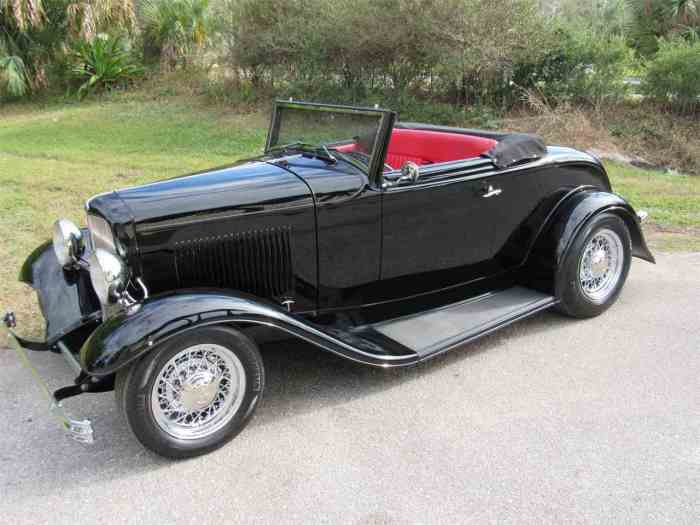
The 1932 Ford Cabriolet, a testament to the ingenuity of its time, boasted a robust mechanical design that delivered both power and efficiency. This section delves into the technical intricacies of the vehicle, exploring its engine, chassis, and other vital components.
Engine Specifications
The 1932 Ford Cabriolet was powered by a 200 cubic inch (3.3 liter) inline four-cylinder engine, known as the “Flathead V8.” This engine, renowned for its durability and simplicity, featured a cast-iron block, a single overhead valve (SOHC) design, and a 4.125-inch bore and 3.75-inch stroke.Here is a detailed table outlining the key engine specifications:
| Specification | Value |
|---|---|
| Engine Type | Inline Four-Cylinder, Flathead |
| Displacement | 200 cubic inches (3.3 liters) |
| Bore x Stroke | 4.125 inches x 3.75 inches |
| Compression Ratio | 4.22:1 |
| Horsepower | 65 hp at 3,400 rpm |
| Torque | 125 lb-ft at 1,600 rpm |
| Fuel System | Carburetor |
| Ignition System | Battery-coil |
| Transmission | Three-speed manual |
Engine Description
The 1932 Ford Cabriolet’s engine, while seemingly basic in design, was a marvel of engineering. Its cast-iron block provided exceptional durability, while the single overhead valve design kept the engine compact and lightweight. The engine’s simplicity, with its straightforward design, made it easy to maintain and repair.The “Flathead V8” earned its nickname due to its flat, non-overhead valve configuration, which resulted in a lower center of gravity and improved stability.
The engine’s relatively low compression ratio (4.22:1) was a design choice aimed at achieving optimal performance with the available fuels of the time.Despite its modest horsepower rating (65 hp), the engine delivered a surprisingly peppy performance, especially considering the Cabriolet’s relatively lightweight design.
The engine’s torque output (125 lb-ft) allowed for brisk acceleration, making the Cabriolet a fun and engaging car to drive.
Chassis and Suspension
The 1932 Ford Cabriolet featured a sturdy and well-engineered chassis that provided a solid foundation for the vehicle. The chassis, constructed from steel, was designed to withstand the rigors of everyday driving. The chassis also played a crucial role in distributing weight evenly across the vehicle, contributing to its balanced handling.The front suspension utilized a transverse leaf spring system, which offered a good balance between ride comfort and handling.
The rear suspension employed a semi-elliptic leaf spring design, known for its simplicity and durability.The suspension system was designed to absorb bumps and uneven road surfaces effectively, providing a comfortable ride for passengers. The chassis and suspension combination delivered responsive handling and a stable ride, making the Cabriolet a pleasure to drive.
Summary
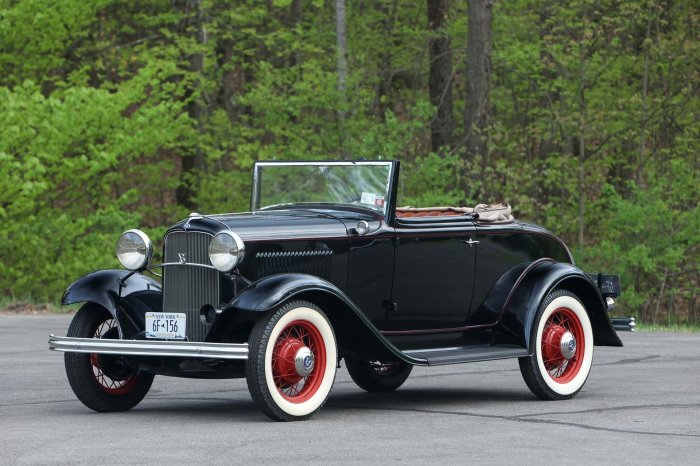
The 1932 Ford Cabriolet stands as a testament to the enduring legacy of American automotive engineering. Its timeless design, coupled with its cultural impact, has secured its place in history as a true icon. Today, the Cabriolet continues to captivate enthusiasts, serving as a reminder of a bygone era and a symbol of American automotive excellence.